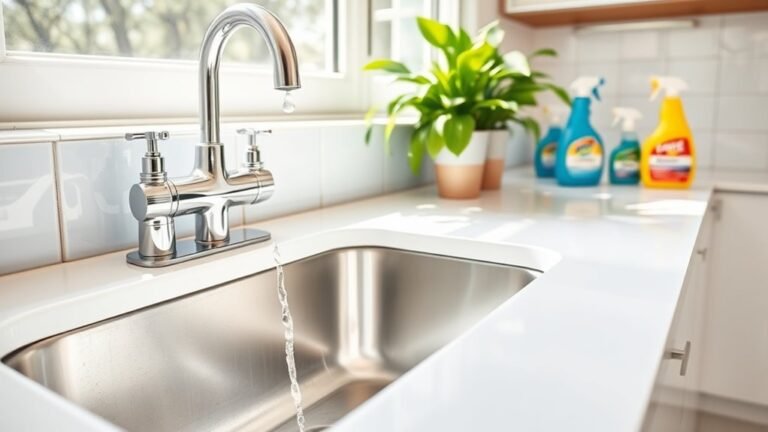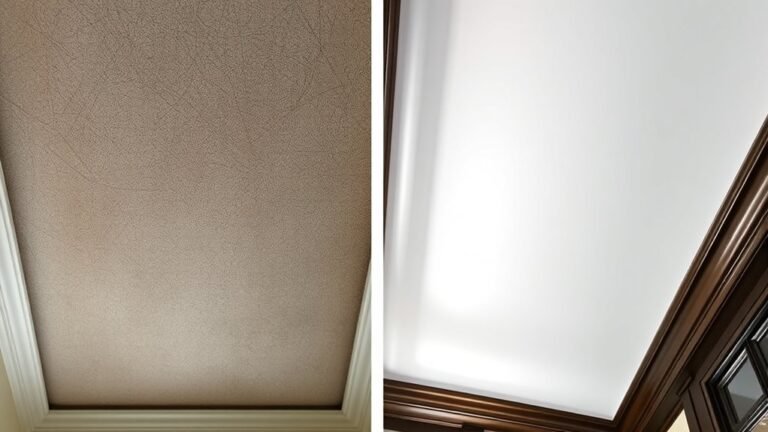How to Clean Allergens
To clean allergens effectively, start by identifying common culprits like dust mites, pet dander, pollen, and mold. Use HEPA filters to capture airborne particles and wash bedding and curtains regularly in hot water. Vacuum carpets and upholstery often, control indoor humidity around 30-50%, and promptly address mold and mildew with safe cleaners. Declutter to reduce dust traps and choose allergen-resistant furnishings. If you want a healthier, more comfortable home, there’s more you can do to tackle these irritants thoroughly.
Identify Common Household Allergens
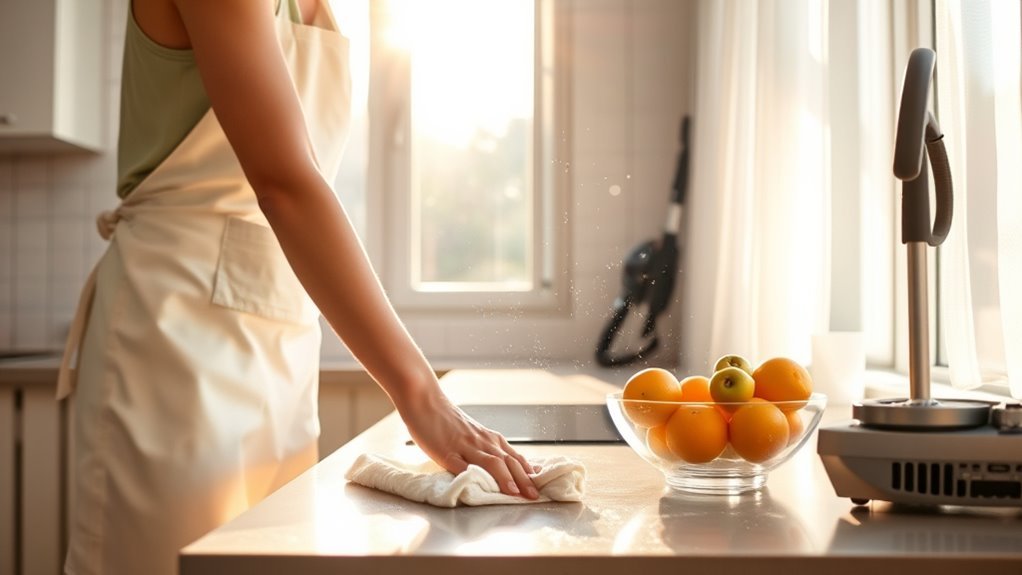
Before you can effectively clean allergens from your home, it’s important to know exactly what you’re dealing with. Common household allergens often include pollen sources tracked indoors from outside plants, especially during peak seasons. These tiny particles can settle on surfaces and fabrics, triggering symptoms if not addressed. Dust mites, microscopic creatures thriving in bedding, upholstery, and carpets, are another prevalent allergen. They feed on dead skin cells and flourish in warm, humid environments. Understanding these allergens empowers you to target your cleaning efforts strategically, reducing their presence and minimizing allergic reactions. By focusing on removing pollen sources and controlling dust mite populations, you gain control over your living space and reclaim your freedom from persistent allergy discomfort.
Use HEPA Filters for Air Purification
While it might seem like allergens are everywhere, you can greatly reduce their presence by using HEPA filters for air purification. These filters capture up to 99.97% of airborne particles as small as 0.3 microns, markedly improving your home’s air quality. By installing a HEPA filter in your HVAC system or using a portable air purifier, you create a cleaner, freer environment. Remember, to keep these filters effective, regular filter maintenance is essential. Replace or clean them according to the manufacturer’s guidelines to avoid clogging, which can reduce airflow and efficiency. With consistent upkeep, HEPA filters help you reclaim your space from allergens, giving you the freedom to breathe easier and live more comfortably without constant allergy worries.
Regularly Wash Bedding and Curtains
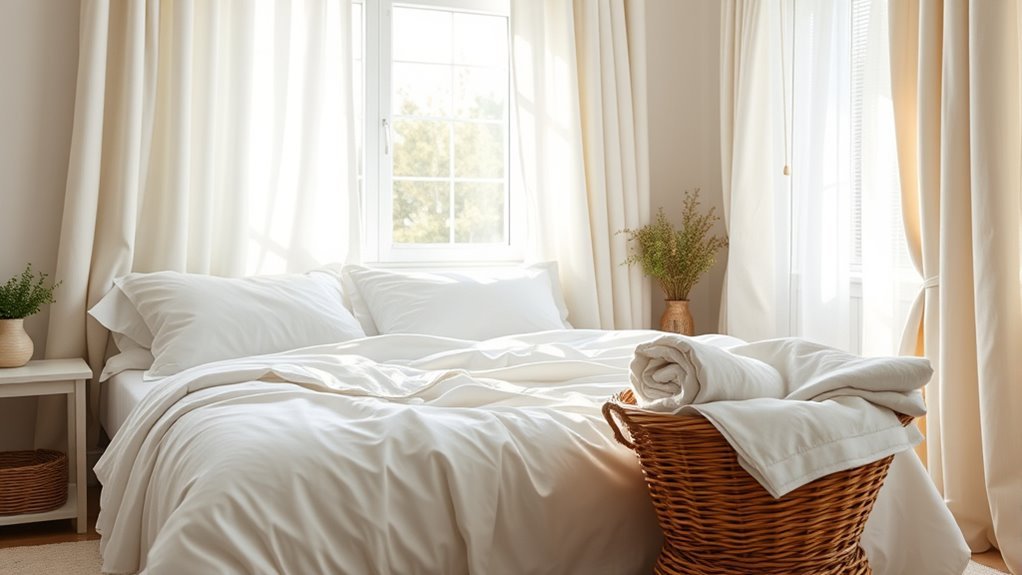
Regularly washing your bedding and curtains is one of the most effective ways to minimize allergens like dust mites, pet dander, and pollen in your home. Consistent bedding care and curtain maintenance prevent allergen buildup, helping you breathe easier and enjoy a fresher environment. Use hot water (at least 130°F) to kill dust mites and remove allergens effectively. Wash curtains every few months, or more if you have pets or pollen allergies.
| Task | Frequency |
|---|---|
| Bedding (sheets, pillowcases) | Weekly |
| Blankets and comforters | Monthly |
| Curtains | Every 3 months |
| Dusting curtain rods | Weekly |
Vacuum Carpets and Upholstery Frequently
You’ll want to vacuum your carpets and upholstery often, especially in high-traffic areas where allergens tend to build up. Using a vacuum with a HEPA filter can capture even the smallest particles, helping reduce allergens effectively. This simple step makes a big difference in keeping your home healthier and more comfortable.
Use HEPA Filters
Because allergens often settle deep within carpets and upholstery, using a vacuum with a HEPA filter is essential to effectively remove them. HEPA filters trap tiny particles that regular vacuums miss, greatly improving your indoor air quality. This means you’re not just moving dust around—you’re actually capturing it, helping you breathe easier and feel more comfortable in your home. To keep your vacuum working at its best, don’t forget filter maintenance. Clean or replace the HEPA filter as recommended by the manufacturer to maintain peak performance. By choosing a vacuum with a reliable HEPA filter and keeping it well-maintained, you’re taking control of your environment, reducing allergen exposure, and gaining the freedom to enjoy your living space without constant irritation.
Vacuum High-Traffic Areas
Vacuuming high-traffic areas at least twice a week can greatly reduce the buildup of allergens in your home. These high traffic zones, like entryways, living rooms, and hallways, accumulate dirt, dust, and pet dander more rapidly. To maximize allergen removal, use vacuum techniques that include slow, deliberate passes to lift particles from deep within carpets and upholstery. Make sure your vacuum has a strong suction and a HEPA filter to trap fine allergens effectively. Don’t forget to vacuum upholstered furniture too, as it harbors allergens that settle from the air. By maintaining this routine, you create a cleaner environment that supports your freedom to breathe easier and live comfortably, without the constant irritation allergens can cause.
Control Indoor Humidity Levels
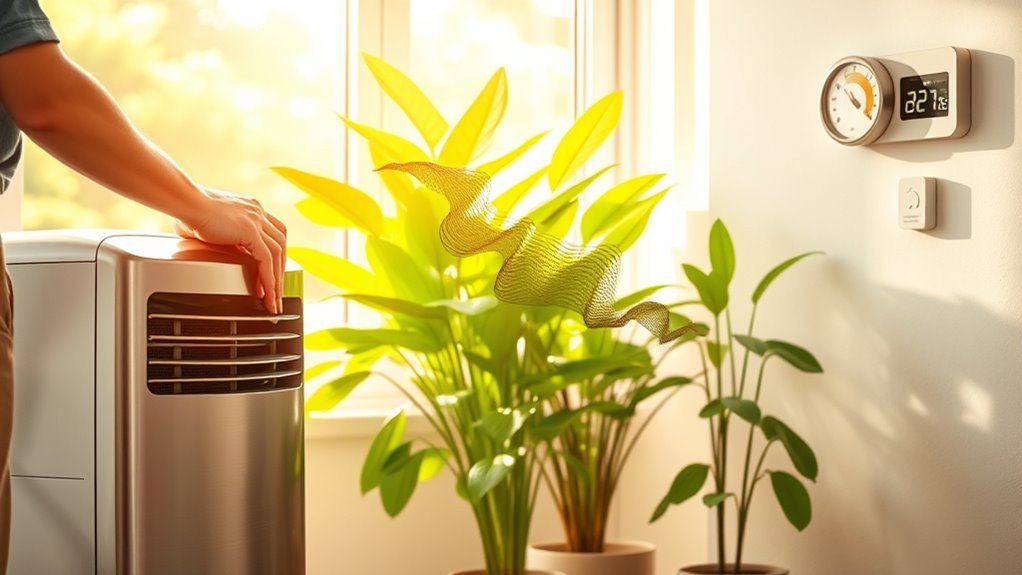
Although it may seem minor, controlling indoor humidity levels plays an essential role in reducing allergens like mold and dust mites. When you manage moisture effectively, you protect your home’s air quality and reclaim your freedom from allergy symptoms.
Here are three key humidity control strategies to help you take charge:
- Use indoor humidity monitoring devices to keep levels between 30-50%, the ideal range to discourage allergen growth.
- Ventilate damp areas regularly, especially kitchens and bathrooms, to prevent moisture buildup.
- Deploy dehumidifiers in problem spots to maintain consistent humidity control.
Clean and Maintain HVAC Systems
When you regularly clean and maintain your HVAC system, you greatly reduce the circulation of allergens like dust, pollen, and mold spores in your home. Following HVAC maintenance tips such as changing air filters monthly and scheduling professional inspections helps keep your system efficient and your air clean. Choosing the right air filter types — from fiberglass to HEPA — impacts allergen control considerably. Here’s a quick comparison:
| Filter Type | Efficiency | Replacement Frequency |
|---|---|---|
| Fiberglass | Low | Monthly |
| Pleated | Moderate | Every 3 months |
| HEPA | High | Every 6-12 months |
| Electrostatic | Moderate to High | Every 3 months |
| UV Light | Supplemental | Annually |
Maintaining your HVAC system grants you freedom from allergens and promotes healthier indoor air quality.
Remove Pet Dander Effectively
Managing pet dander is essential if you want to lessen allergy symptoms in your home. Pet dander clings to surfaces and fabrics, triggering discomfort. To regain your freedom from allergens, focus on these steps:
Managing pet dander is key to reducing allergies and creating a more comfortable, allergen-free home environment.
- Regular pet grooming: Brush your pet often and bathe them using hypoallergenic shampoos to reduce dander at the source.
- Use allergen proof bedding: Cover your pet’s sleeping areas and your own beds with allergen-proof covers to block dander penetration.
- Clean frequently: Vacuum with a HEPA filter and wipe surfaces to remove settled dander.
These targeted actions help you breathe easier and feel more comfortable in your space. Taking control over pet dander means reclaiming your home’s cleanliness and your well-being without sacrificing your love for pets.
Eliminate Mold and Mildew
You might not always notice mold and mildew right away, but spotting them early is key to keeping your home allergen-free. Using the right cleaning solutions can effectively remove these unwanted growths without causing harm. Plus, taking simple steps to control moisture will help you prevent mold from coming back in the future.
Identifying Mold Growth
Mold growth often appears as discolored spots or patches on surfaces, ranging from black and green to white or gray. Recognizing different mold types is essential for effective mold removal and protecting your space. You want to catch mold early before it spreads and impacts your freedom to enjoy a healthy environment.
Here’s what to look for:
- Texture changes – Mold can look fuzzy or slimy, often feeling damp or musty.
- Hidden spots – Check behind walls, under sinks, or in damp corners where mold loves to hide.
- Odor – A persistent earthy or musty smell often signals mold presence, even if you can’t see it.
Identifying mold growth quickly helps you reclaim your space and breathe easier.
Effective Cleaning Solutions
Three key cleaning solutions stand out when it comes to eliminating mold and mildew effectively: vinegar, hydrogen peroxide, and baking soda. These natural cleaning agents offer powerful, eco friendly solutions without harsh chemicals, helping you maintain a healthy, allergen-free space. Vinegar’s acidity breaks down mold spores, while hydrogen peroxide acts as a strong antifungal and antibacterial agent. Baking soda not only scrubs away residue but also neutralizes odors. When using these, spray vinegar or hydrogen peroxide directly on the affected area and let it sit for 10-15 minutes before scrubbing. For stubborn spots, sprinkle baking soda, then spray vinegar to create a fizzing action that lifts mold. Choosing these natural cleaning options empowers you to protect your home and health sustainably, giving you the freedom to breathe easier without compromising the environment.
Preventing Future Mold
Although cleaning existing mold is essential, preventing future growth is even more important to maintain a healthy home environment. You deserve a space free from harmful allergens and improved indoor air quality. Implement these mold prevention strategies to protect your freedom to breathe easy:
- Control humidity levels by using dehumidifiers and ensuring proper ventilation, especially in damp areas like bathrooms and basements.
- Fix leaks promptly to eliminate moisture sources that mold thrives on, preventing hidden infestations.
- Use mold-resistant products such as paints and drywall to create barriers against mold growth.
Minimize Clutter to Reduce Dust
Since dust tends to accumulate on surfaces where items gather, reducing clutter is one of the most effective ways to minimize allergens in your home. You can start by implementing simple declutter strategies, like sorting items into keep, donate, or discard piles. These organizing tips help you maintain clear surfaces, making dusting easier and more thorough. Focus on essential belongings and store them in closed containers to prevent dust buildup. Remember, a clutter-free space doesn’t just reduce allergens; it also creates mental clarity and freedom. Taking small, consistent steps will keep your living area cleaner and more comfortable. By minimizing clutter, you’re not just reducing dust—you’re reclaiming your space and peace of mind.
Choose Allergen-Resistant Furnishings
When selecting furnishings, choosing hypoallergenic materials can greatly reduce allergen buildup. Opt for easy-to-clean fabrics like leather or tightly woven textiles that don’t trap dust and pet dander. You’ll also want durable allergen barriers to keep your furniture protected and your space healthier.
Hypoallergenic Material Options
If you want to reduce allergens in your home, choosing hypoallergenic materials for your furnishings is a smart move. These allergen free materials help create a safer, more comfortable space where you can breathe freely without constant irritation.
Here are three hypoallergenic material options to contemplate:
- Leather or Faux Leather – These surfaces don’t trap dust mites or pet dander like fabric upholstery does, making them allergen resistant.
- Hypoallergenic Fabrics – Look for tightly woven fabrics like microfiber or synthetic blends designed to repel allergens.
- Wood and Metal Furniture – Hard surfaces are less hospitable to allergens and easy to wipe clean, maintaining a healthier environment.
Easy-to-Clean Fabric Choices
Although selecting hypoallergenic materials is important, choosing easy-to-clean fabric options can further reduce allergens in your home. When picking soft furnishings, look for allergen free textiles like tightly woven cotton, microfiber, or leather alternatives that don’t trap dust and pet dander. These fabrics allow you to clean surfaces quickly and thoroughly, minimizing allergen buildup. Avoid heavy, plush materials that hold onto particles and require frequent deep cleaning. Easy-to-clean fabrics offer you freedom from constant maintenance, helping you maintain a healthier environment effortlessly. By choosing smart, allergen-resistant furnishings, you lower allergen exposure without sacrificing comfort or style. This approach supports your desire for a clean, breathable space where you can relax and breathe freely every day.
Durable Allergen Barriers
Three key factors make durable allergen barriers essential for maintaining a low-allergen environment in your home. Choosing the right allergen barrier materials guarantees your furnishings resist dust mites, pet dander, and pollen effectively. Durable fabric options not only protect but also withstand regular cleaning without losing their protective qualities. This gives you freedom from constant worry about allergens infiltrating your living space.
- Protection: Durable allergen barriers create a strong shield, reducing allergen buildup and improving air quality.
- Longevity: High-quality fabrics endure frequent washing, keeping your home consistently safe.
- Comfort: Allergen-resistant furnishings maintain comfort without compromising style or freedom of movement.
Frequently Asked Questions
Can Certain Houseplants Help Reduce Indoor Allergens?
Yes, certain air purifying plants can help improve your indoor air quality by reducing allergens. Plants like snake plants, spider plants, and peace lilies absorb toxins and increase humidity, which can ease allergy symptoms. While they won’t eliminate allergens completely, they’re a natural, low-maintenance way to support a healthier environment. You’ll enjoy fresher air and a bit more freedom from irritants in your living space.
What Natural Remedies Can Neutralize Allergens in the Home?
Seeking simple, soothing solutions? You can naturally neutralize nuisances by using essential oils like eucalyptus or lavender—they freshen and fight allergens effectively. Vinegar solutions serve as superb sanitizers, breaking down dust and mold without harsh chemicals. These natural remedies grant you greater freedom from irritants, promoting a purer, peaceful home environment. Just remember to test any new product to guarantee it suits your space and sensitivities safely.
How Often Should Air Ducts Be Professionally Cleaned?
You should have your air ducts professionally cleaned every 3 to 5 years to maintain ideal air quality and guarantee proper duct maintenance. If you or your loved ones suffer from allergies or respiratory issues, more frequent cleanings might be necessary. Regular duct cleaning helps reduce dust, mold, and allergens, giving you the freedom to breathe easier and enjoy a healthier home environment without worrying about hidden contaminants circulating through your air system.
Are There Specific Cleaning Products That Worsen Allergies?
Yes, some cleaning products can worsen allergies, especially if you have chemical sensitivities. You’ll want to avoid cleaners with strong fragrances or harsh chemicals, as they often trigger reactions. Instead, opt for fragrance-free cleaners designed to minimize irritation. These products help keep your environment safe and comfortable, giving you the freedom to maintain cleanliness without compromising your health or well-being. Always check labels and choose gentle, allergen-friendly options.
Can Allergen Exposure Outdoors Affect Indoor Allergen Levels?
Yes, outdoor pollen can definitely affect your indoor air quality. When you spend time outside, pollen sticks to your clothes, hair, and skin, and then enters your home. This increases indoor allergen levels, which can trigger symptoms even when you’re inside. To keep your space fresh, it’s smart to change clothes and shower after being outdoors. This way, you can enjoy freedom from allergy discomfort both inside and out.


